Abstract
The subject of the work was the evaluation of maize protein yield conditioned by various agrotechnical factors. The test results are derived from two different field experiments covering a total of seven years of observation. Protein yield was significantly dependent on changing weather conditions in the growing seasons. Protein yield was significantly lower in the dry and hot years. The sum of precipitation for the month of May was positively correlated with maize protein yield. However, there was no correlation between the average air temperature and the amount of protein yield. The sum of atmospheric precipitation for the entire growing season (IV–X) shaped maize protein yield in over 96%. A non-linear relationship of the 2nd degree was determined between these traits. Sowing maize into the soil cultivated traditionally (autumn tillage), “stay-green” type cultivars and row fertilization positively influenced maize protein yield. Initial fertilization (regardless of depth) with two-component NP fertilizer, in relation to broadcast fertilization, significantly increased maize protein yield from 11.4% to 18%, respectively. The type of nitrogen fertilizer did not differentiate the value of this trait. Pre-sowing nitrogen application was more effective compared to the top dressing, and significantly increased protein yield. Row fertilization with two-component NP fertilizer clearly affected the content protein in grain. The interdependence of genetic and agronomic progress is an important factor shaping the potential of maize protein yield and cannot be attributed to either breeding (cultivar) or agronomy.
1. Introduction
Cereals, including maize, are the basis of daily food [1,2]. Maize accounts for 15% of world protein production and 19% of calories from vegetable crops [3]. To alleviate malnutrition, maize protein content can be increased even up to 18% by increasing the prolamine (zein) fraction in the endosperm of maize kernels [4]. Millions of people around the world, especially in developing countries, obtain part of their protein and daily calories solely from maize [5].
In the conditions of food shortage in the world, particularly in developing countries, supplying the right amount of energy is an important problem, and thus cereals that are a source of protein become very important. Nutritional needs in terms of basic nutrients, including energy compounds and proteins, are mainly met by plant production. Plant raw materials are also a source of other valuable components that are not energy materials, but they determine the bioavailability of food macronutrients and affect health. Therefore, new raw materials, such as white mulberry (Morus alba), are currently being sought to obtain or enrich food with polyphenols, vitamins and minerals [6]. Currently, optimal cultivars are also selected to achieve not only high yields but also high antioxidant potential [7,8].
These activities are constantly accompanied by work on optimizing cultivation conditions, including the selection of appropriate fertilization methods. The aim of modern maize breeding is to obtain high-yielding cultivars with improved quality characteristics, high nutritional value and disease resistance [9]. A very important task of breeding is to obtain high protein content in the grain. Protein content in the grain is not only a cultivar trait, but also depends on climate and soil conditions, fertilization and chemical protection. The main product of maize grain milling is thick groat, known as grits, obtained from the vitreous part of the endosperm. Allergies and food intolerances are a very big threat in the present world [10]. The only alternative for people on a gluten-free diet is to consume modern products that are safe for them, which increasingly includes bread baked from flour based on gluten-free cereals, e.g., maize. Cereal protein is often included in the so-called deficient proteins due to a shortage of some essential amino acids—in the case of maize, these are lysine and tryptophan [3,11]. However, according to recent findings of WHO and FAO 2007 [12] experts, human demand for tryptophan currently amounts to 6 mg·g−1 protein. Thus, it can be concluded that tryptophan is no longer an amino acid that limits the biological (nutritional) value of maize protein. Rastogi and Shukla [13] also confirmed the low biological value of the protein, indicating tryptophan and lysine as limiting amino acids.
The development of plant breeding techniques has enabled the acquisition of the so-called quality protein maize (QPM) cultivars. QPM cultivars contain approximately twice as many of the aforementioned amino acids as compared to standard cultivars, thanks to which their proteins are much more similar to the amino acid composition of casein, and thus have a significantly higher nutritional value [3,14]. Maize protein is characterized by a very high content of branched-chain amino acids (isoleucine, leucine, valine) that play an important role in human metabolism [15]. Branched-chain amino acids have distinct biological properties from other amino acids and are not catabolized in the liver, but in skeletal muscles. For this reason, they are often used by athletes as supplements for building muscle mass [16,17]. In addition to the beneficial effects of using supplements in athletes’ diets, some researchers point out the harmful effects of branched-chain amino acids on the health of people with low physical activity. Many studies have shown an increased risk of obesity, type 2 diabetes and amyotrophic lateral sclerosis [18,19].
Demand for food is higher due to the growing population [1]. Therefore, maize can meet nutritional needs as well as provide food for humans and a number of health benefits [2,20]. According to long-term predictions, demand for maize will double by 2050, and its production by 2025 will dominate cereal production, especially in developing countries [1]. There are few data in the literature on the effect of agrotechnical factors on maize protein yield [3,21].
Therefore, field studies were conducted at the Department of Agronomy of the Poznań University of Life Sciences to determine the effect of selected agrotechnical factors on maize protein content and yield. The experimental hypothesis assumed that various agrotechnical factors: (i) method of soil preparation for sowing, (ii) maize hybrid type, (iii) fertilization method, (iv) NP fertilizer application depth, (v) nitrogen fertilizer type, and (vi) N application date would shape the size of maize content and protein yield. The adopted assumptions were verified on the basis of two field experiments carried out over a period of seven years.
2. Materials and Methods
2.1. Experimental Field
2.1.1. Experiment I
The field experiment was carried out at the Department of Agronomy of Poznań University of Life Sciences, on the fields of the Gorzyń Experimental and Educational Unit (52°26′ N; 16°45′ E), in the years 2012–2014. It was carried out for three years in the same scheme in a split-split-plot design with three factors in 4 field replicates. The study involved the following factors: A-1st order factor-two methods of maize sowing: A1-sowing to the soil (traditional cultivation), A2-direct sowing to the stubble after winter wheat (straw harvested); B-2nd order factor-two types of varieties: B1-traditional variety SY Cooky, B2-stay-green variety Drim; C-3rd order factor-2 methods of supplying NP fertilizer: C1-broadcast on the entire surface before seed sowing, C2-in rows simultaneously with seed sowing. The same level of mineral fertilization (100 kg N·ha−1, 30.8 kg P·ha−1 and 107.9 kg K·ha−1) was applied on all experimental objects. Fertilization was balanced against phosphorus, which was applied at the whole required dose in the form of ammonium phosphate under the trade name of polidap NP. N and K fertilization was performed before maize sowing using urea and potassium salt (60%). The N dose was reduced by the amount of nitrogen present in the polidap. The assumed planting density in the years of research was 7.95 pcs·m−2, with a spacing between rows of 70 cm and a sowing depth of 5–6 cm. The size of the plot area for harvesting was 14 m2.
2.1.2. Experiment II
A field trial was carried out at the Department of Agronomy of Poznań University of Life Sciences, on the fields of the Gorzyń Experimental and Educational Unit (52°26′ N; 16°45′ E), in the years 2015–2018. It was conducted for four years in the same random block design (split-split-plot) with 3 factors and 4 field replicates. The following variables were tested: A-1st order factor-NP fertilizer sowing depth [A1-0 cm (broadcast), A2-5 cm (in rows), A3-10 cm (in rows), A4-15 cm (in rows)]; B-2nd order factor-type of supplementary nitrogen fertilizer [B1-ammonium nitrate, B2-urea]; C-3rd order factor-date of supplementary nitrogen fertilization [C1-before sowing, C2-top dressing in the BBCH 15/16 stage]. The same level of mineral fertilization (100 kg N·ha−1, 30.8 kg P·ha−1 and 107.9 kg K·ha−1) was applied in all experimental objects. Fertilization was balanced against phosphorus, which was applied at the whole required dose in the form of ammonium phosphate (18% N, 46% P2O5), according to the experimental design under the 1st order factor. K fertilization was performed before maize sowing using potassium salt (60%). The fertilizer coulters (on objects with initial fertilization) were set 5 cm aside from the seeds. The application depth of NP fertilizer was according to the 1st order factor levels. Maize sowing was performed with a precision seeder, with a built-in granular fertilizer applicator (Monosem). Gross plot size: 24.5 m2 (length-8.75 m, width-2.8 m). The net plot area for harvesting was 12.25 m2.
2.2. Methods of Parameter Determination
In the present study nitrogen content in grain was assessed using the Kjeldahl method with the KjeltecTM 2200 FOSS device. Next nitrogen content in grain was multiplied by 6.25, and protein content in grain was thus calculated. Protein content was determined for the bulk sample from four replications.
% Protein = %N × 6.25
Yield of protein [kg ha−1] = [(yield of dry grain kg·ha−1 × protein content in grain %)]/100.
2.3. Soil Conditions
The morphological structure of the experimental field is typical of the bottom moraine of the North Polish (Baltic) glaciation, the Poznań stadium. The parent materials of the soil are clay or sandy-loam formations. The terrain’s configuration shows little differentiation, the dominant terrain is flat and low undulating. Typologically, the soils of the test field belong to the black-earth type, a subtype of cambic black-earth, which belongs to the black-earth order. According to the international classification of WRB (World Reference Base), the studied soils should be classified as Phaeozemes, and according to the US Soil Taxonomy as Mollisols. In terms of soil valuation, the experimental field was classified as IIIb class. The black-earth type includes soils where the direct influence of groundwater or heavy rainfall covers the lower and part of the middle part of the soil profile. In the surface horizons, rainfall and water management dominates, which can be modified to some extent by changing the water properties of the deeper parts of the soil profile. The content of nutrients in the soil before sowing maize is given in Table 1. The magnesium content in the soil was determined by the Schachtschabel method, the content of potassium by the Egner-Riehm method, the content of phosphorus by the Olsen method and the content of organic carbon with the Vario-Max autoanalyzer.

Table 1.
Total nutrient contents and soil pH before establishing the experiment in maize growing seasons.
2.4. Statistical Analysis
The statistical analyses, such as the analysis of variance (ANOVA) and Tukey’s HSD (honestly significant difference) test for comparisons of pairs of means were performed separately in the study years and over the years 2012–2014 and 2015–2018, according to the models of data obtained from the experiment designed as a split-split-plot [22]. In a further step, analyses of variance were supplemented with polynomial regression analyses [23] taking into account information from both experiments. The aim of this study was to investigate whether maize protein and temperature and humidity conditions during the maize growing season significantly affect the size of maize protein yield. The average values of protein yield in individual years, the sum of atmospheric precipitation and the average daily air temperature in maize growing seasons were taken into account. All calculations were carried out using the Statistica 13 software package 2017 [24]. Statistical significance was defined at p-value < 0.01 or p-value < 0.05 depending on the source of variation.
3. Results
3.1. Weather Conditions
The meteorological data came from the iMetot automatic station located in the experimental field. Generally, it should be stated that the thermal and humidity conditions in the maize growing seasons were very diverse (Figure 1). The most optimal conditions for maize growth and development were recorded in the years 2012, 2016 and 2017. The worst meteorological conditions for maize growth and development were recorded in 2015 and 2018. These were the years with the lowest precipitation, below 300 mm.
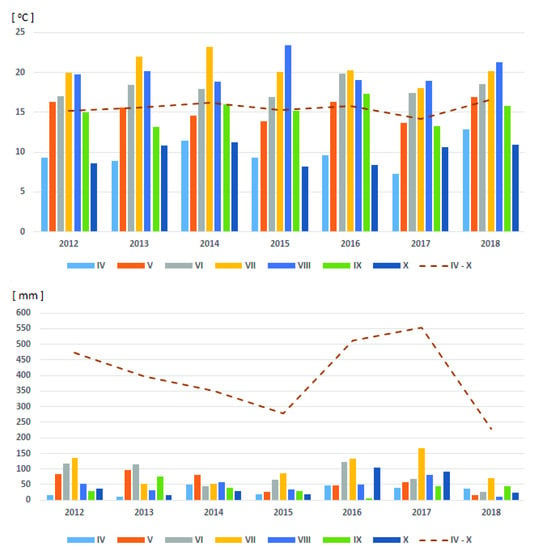
Figure 1.
The sum of atmospheric precipitation and the average daily air temperature in maize growing seasons.
3.2. Protein Content-Experiment I
From the analysis of the protein content in corn grain (g·kg−1) in Experiment I, it was found that the applied agrotechnical factors, i.e., the methods of sowing maize, the varieties, and the methods of applying NP fertilizer, as well as all interactions between them, did not significantly differentiate the mean protein contents in the grain (Table 2). Table 3 presents the means for agrotechnical factors, in spite of the statistically insignificant differences. These data only provide information about the protein content in the grain in a given environment, subject to the factors specified in this experiment.

Table 2.
Results of the three-stratum ANOVA for the protein content (2012–2014).

Table 3.
Mean values of the protein content for the factors (2012–2014).
3.3. Protein Yield—Experiment I
In the three-year study period (2012–2014), significant differences in protein yield (kg/ha) were found depending on the interaction of methods of sowing maize, varieties, and methods of applying NP fertilizer with those years (Table 4). The highest protein yield (irrespective of the agronomic factors) was obtained in 2013 and 2014, which had average air temperatures close to the long-term temperature and had the lowest amount of precipitation. Excessive precipitation and a temperature below the long-term average in 2012 had an adverse effect on the mean protein yield, which was significantly lower than the mean protein yield in 2013 (Table 5). The evaluated maize varieties differed significantly in terms of protein yield (irrespective of the years and other agronomic factors). A significantly higher mean yield was obtained by the stay-green variety compared with the traditional variety (Table 5).

Table 4.
Results of the four-stratum ANOVA for the protein yield (2012–2014).

Table 5.
Mean values of the protein yield for the years and other factors (2012–2014).
During the three-year study period, the stay-green variety obtained the highest yields in 2013 and 2014 (irrespective of methods of sowing maize and applying NP fertilizer). The mean yields of this variety were significantly higher than the mean yields of the traditional variety, especially in 2013 and 2014 (Table 6). The studies also showed the interactive impact of varieties, methods of sowing maize and weather conditions in the years of the study on the protein yield (kg·ha−1). Significantly, the highest protein yield (1163.1 kg·ha−1) was obtained from grain of the stay-green variety sown in soil cultivated in the traditional way in 2013. Significantly, the lowest yield (757.6 kg·ha−1) was found for the traditional variety with direct sowing in 2014 (Figure 2).

Table 6.
Mean values for the combinations Y × A and Y × B (2012–2014).
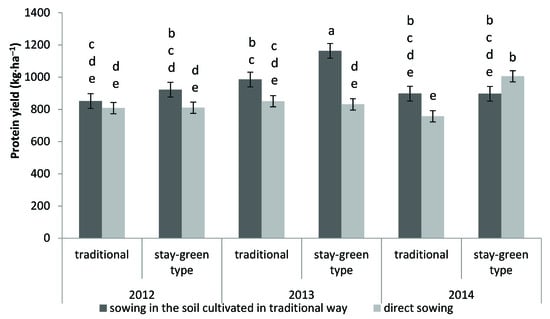
Figure 2.
Mean values of the protein yield for the combinations of three years; two methods of sowing maize and two types of varieties (YAB); a, b, c, d, e—homogeneous groups (α = 0.01).
The research also showed the interactive effect of the method of sowing maize, the method of applying NP fertilizer and weather conditions in the years of the study on the protein yield (kg·ha−1). A significant increase in protein yield (1134.0 kg·ha−1) was obtained (irrespective of the varieties) in 2013 when maize was sown in soil cultivated in the traditional way and NP fertilizer was applied in rows. Significantly, the lowest mean yield (764.3 kg·ha−1) was found in 2012 when direct sowing and broadcasting of NP fertilizer were used (Figure 3).
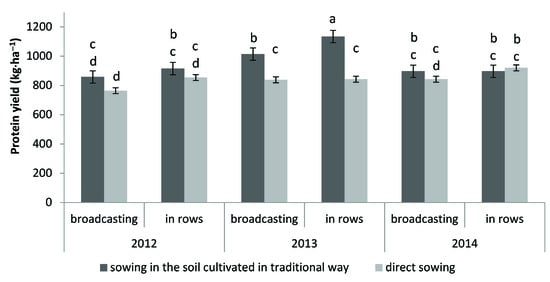
Figure 3.
Mean values of the protein yield for the combinations of three years; two methods of sowing maize and two methods of sowing NP fertilizer (YAC); a, b, c, d—homogeneous groups (α = 0.01).
A significant interaction of all agronomic factors with the years of research was also found (Table 4). A significant increase in the protein yield was obtained for the stay-green type variety, when NP fertilizer was applied in rows, while maize was sown in soil cultivated traditionally (in 2013) or through direct sowing (2014).
3.4. Protein Content—Experiment II
In Experiment II, significant differences in the mean protein content were found only depending on the depth of NP fertilization and on the interaction between the depth of NP fertilization and the date of supplementary nitrogen fertilization (Table 7 and Table 8). It was shown (Figure 4) that relative to broadcast NP, the protein content in the grain increased significantly when NP fertilizer was sown at a depth of 10 cm before the application of supplementary nitrogen (irrespective of its type, i.e., ammonium nitrate or urea). However, the other sowing depths (5 cm or 15 cm) did not significantly change the protein content in the grain, relative either to broadcast NP or to sowing at a depth of 10 cm.

Table 7.
Results of the three-stratum ANOVA for the protein content (2015–2018).

Table 8.
Mean values of the protein content for the factors (2015–2018).
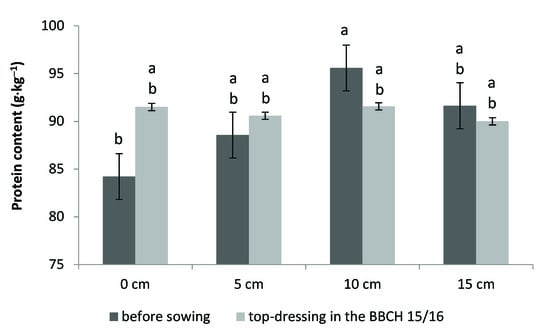
Figure 4.
Mean values of the protein content for the combinations of four depths of fertilization and two dates of nitrogen application (AC) in 2015–2018; a, b—homogeneous groups (α = 0.05).
3.5. Protein Yield—Experiment II
In the four-year research period (2015–2018), significant differences in protein yield (kg·ha−1) were found depending on the interaction of agrotechnical factors—depth of fertilization, type of nitrogen fertilizer and date of nitrogen application—with those years (Table 9). Significantly, the highest mean protein yield was found in 2016 (irrespective of the agrotechnical factors) and the lowest mean protein yield was obtained in 2018 (Table 10). A depth of fertilization of at least 5 cm significantly increased the protein yield. However, further increasing the depth to 10 or 15 cm did not significantly increase the yield (Table 10). No interaction was found between this factor and the year of research. No significant differences in protein yield were obtained under the influence of the nitrogen fertilization method (irrespective of years and other agrotechnical factors). On the other hand, mean protein yields differed significantly due to the applied nitrogen fertilization methods in various years (the interaction is significant). The highest yields were obtained in 2016, using both ammonium sulphate and urea. In 2018, mean protein yields were significantly the lowest, while the methods of nitrogen fertilization did not differentiate the means (Table 11). However, the studies showed the interactive effect of the depth of fertilization, type of nitrogen fertilizer and weather conditions in the years of research on the protein yield. The interaction of these factors was studied independently of the year (Figure 5). A greater increase in yield was obtained using a depth of fertilization with urea of at least 5 cm. Considering the years of research, the highest protein yields were obtained in 2016 using urea with a fertilization depth of at least 5 cm. Studying the impact of the date of nitrogen application on protein yield and the interaction of this factor with the years and other factors, a lack of interaction was found only between the type of nitrogen fertilizer and the date of application. The other interactions are highly significant (Table 9). Irrespective of the study year and other agrotechnical factors, the highest protein yield was obtained using nitrogen application before sowing (Table 10). Considering the interaction of the date of nitrogen application with the year, the highest yield was found in 2016, when the date of application (before sowing, or top-dressing at BBCH 15/16) did not differentiate mean protein yields. A similar situation was obtained in 2018, when mean yields were significantly the lowest (Table 11). It was also shown (Figure 6) that protein yield increased significantly when nitrogen was applied before sowing and a 10 cm depth of fertilization was used (irrespective of the study years). Considering the significant interaction of both factors with the years of research (Table 9), the highest yields were found in 2016. The highest mean yield was obtained for nitrogen application before sowing and a 15 cm depth of fertilization.

Table 9.
Results of the four-stratum ANOVA for the protein yield (2015–2018).

Table 10.
Mean values of the protein yield for the years and other factors (2015–2018).

Table 11.
Mean values for the combinations Y × B and Y × C (2015–2018).
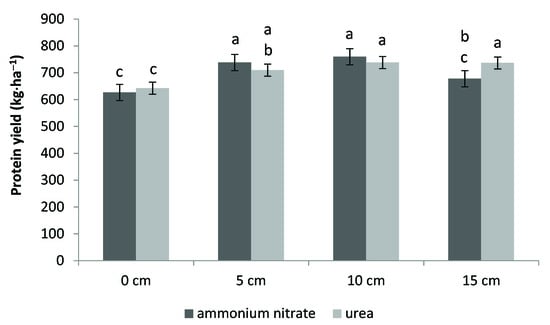
Figure 5.
Mean values of the protein yield for the combinations of four depths of fertilization (A) and two types of nitrogen fertilizer (B) in 2015–2018; a, b, c—homogeneous groups (α = 0.01).
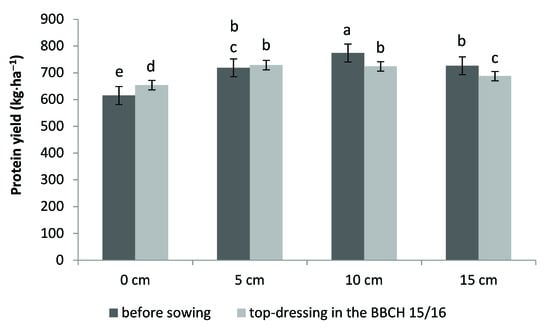
Figure 6.
Mean values of the protein yield for the combinations of four depths of fertilization (A) and two dates of nitrogen application (C) in 2015–2018; a, b, c, d, e—homogeneous groups (α = 0.01).
In the four-year study period, the significantly highest yields were obtained for the combination of type of nitrogen fertilizer and the date of nitrogen application in 2016 (irrespective of the depth of fertilization). It was found that both ammonium sulphate and urea used before sowing or with top-dressing at BBCH 15/16 did not significantly differentiate mean protein yields (Figure 7). When considering (Table 12) a combination of three (A, B, C) factors (regardless of the year of research), a significant increase in the mean values of the protein yield was observed when a sowing depth of at least 5 cm was used. The highest means of the yields were observed for the ammonium nitrate and urea used before sowing at a sowing depth of 10 cm. However, these means do not differ significantly from many other means of the protein yield for A × B × C combinations with a sowing depth of at least 5 cm. Considering the significant interaction of all factors with the years of research (Table 9), the highest yields were found in 2016, wherein the significant highest mean yield was obtained for urea application before sowing and a 15 cm depth of fertilization.
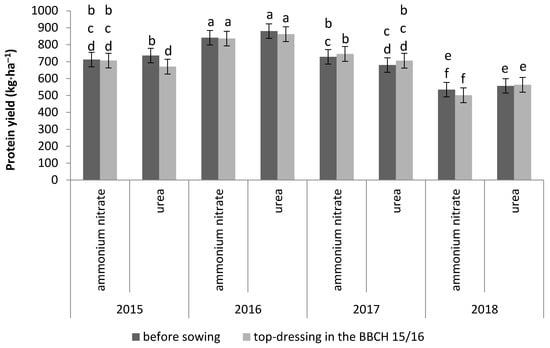
Figure 7.
Mean values of the protein yield for the combinations of four years; two types of nitrogen fertilizer and two dates of nitrogen application (YBC); a, b, c, d, e, f—homogeneous groups (α = 0.01).

Table 12.
Mean values for the combinations of four depths of fertilization (A), two types of nitrogen fertilizer (B) and two dates of nitrogen application (C) in 2015–2018.
3.6. Functional Relationships
Functional relationships between the sum of precipitation and the average daily air temperature and maize protein yield were calculated in the current study (Table 13 and Table 14). It was shown that the sum of precipitation in the 4th month affected protein yield in over 76%. The correlation coefficient for this relationship was rxy = 0.8757 > 0, and thus the described relationship between these traits was positive. For May, a linear relationship was found between the sum of precipitation and protein yield, which was significant at the level of α = 0.01 (p = 0.009780). In turn, the sum of atmospheric precipitation for the IV–X period had an effect on protein yield of over 96% (Table 13). A non-linear, 2nd degree relationship between the sum of precipitation and protein yield was found, which was significant at the level of α = 0.01 (p = 0.000620). The average daily air temperature in the 4th month and the IV-X period affected maize protein yield in over 91% and 89%, respectively (Table 14). A non-linear, 2nd degree relationship was demonstrated for May, which was significant at the level of α = 0.01 (p = 0.002699). In turn, for the entire growing season, a 3rd degree non-linear relationship was recorded between the average daily air temperature and protein yield, which was significant at the level of α = 0.05 (p = 0.045429).

Table 13.
Functional relationships between the sum of precipitation and protein yield (kg·ha−1) in 2012–2018.

Table 14.
Functional relationships between the average air temperature and protein yield (kg·ha−1) in 2012–2018.
4. Discussion
Maize is one of the most important plant raw materials, with versatile applications, including non-food and non-agricultural purposes [20]. The maximum grain yield (15% H2O) in the USA was 28.5 t/ha, i.e., 75% of the potential yield. Assuming that the harvest index (HI) is about 50% for maize, the collected biomass can amount to 60 t dm·ha−1 [25].
Maize grain yield (also protein yield) is largely determined by the availability of water. Maize crops are limited by a number of abiotic and biotic factors [26]. Hence, plant production may not meet its goals without introducing new technological solutions. Water shortages in the plant limit the supply of leaf assimilates, which are deposited in the form of starch already at the early stages of kernel development, leading to ovary necrosis and discarding young kernels [27]. Water plays an important role in the formation of starch granules during the growth of kernels [28]. Any disturbances in the system of environmental factors cause an imbalance in the plant’s vital functions and become a cause of stress. The above-mentioned functional relationships between humidity and thermal conditions and protein yield show that maize malnutrition interferes with leaf, ear and ear element structure formation processes at the initial period of the growing season [29,30]. These effects of nitrogen deficiency are visible very early, already in the 8-leaf stage. According to Subedi and Ma [31], plant nitrogen malnutrition before this phase leads to an irreversible reduction in the number of ears and formed kernels by approximately 30%. Szulc and Bocianowski [32] also reported that maize grain yield was significantly dependent on the plant nutritional status in the BBCH 15/16 leaf stage, regardless of the type of maize hybrid.
The biological value of maize kernels is determined based on protein and fat content as well as the composition of amino acids and fatty acids [33]. Their quality and content can be modified by ecological and agrotechnical factors. Among the latter, the effect of nutrients (fertilization) on their content is the most visible. Plants with better nitrogen nutrition increase protein content [11]. Climatic conditions, mainly humidity, also have a great impact on protein content in maize kernels. It was found that protein content in maize kernel was lower in wet years than in dry and warm years [21]. According to Sulewska and Ptaszyńska [34], maize protein content was more strongly shaped by weather conditions than by the genotype. Hopkins [35] also reported that weather conditions during the growing season had a great impact on crop yielding and any deviation from the average values affected agricultural production. Excess or no rainfall, as well as too low or too high air temperature largely determined crop yielding stability. The aforementioned results were also confirmed in the present study. Significantly, the lowest protein yield was obtained in 2018 (538.7 kg of protein·ha−1), which was characterized by the lowest total precipitation for the maize growing season (230.3 mm), with the highest daily air temperature (16.6 °C). Regardless of weather conditions in the successive years, a significantly higher grain yield was obtained for maize sown in the cultivated soil compared to direct sowing in stubble. The difference between sowing methods was 108.8 kg·ha−1. The results of other studies [36] also have demonstrated that the tillage method has a strong impact on the level of maize yielding. The view that the use of simplified cultivation, especially direct sowing [37], causes a significant reduction in grain yield prevails in the literature, as also shown by our own research. In the current study, the highest protein yield was harvested by cultivating a “stay-green” type cultivar compared to a traditional cultivar. The result obtained in our research confirmed earlier literature reports about a significantly higher protein yield in case of growing a “stay-green” cultivar [21,38]. According to Szulc et al. [21], this hybrid is more environmentally friendly and better suited to integrated maize cultivation compared to a traditional hybrid due to its higher capacity to utilize soil nitrogen (Nmin) and fertilizer. This was evidenced by a higher protein content in the grain and protein yield regardless of nitrogen dose, type of nitrogen fertilizer and magnesium application.
Broadcast fertilization does not always ensure proper plant nutrition, because, depending on soil properties, part of the ingredient introduced into the soil in the form of fertilizer will become fixed, especially on soils with high immobilization propensity, or will land in places that are beyond the reach of crop roots [39]. A much better way to increase phosphorus availability is to place the fertilizer in close proximity to the seeds [40]. This type of fertilizer application is called row, initial or localized. It results in a better supply of young plants with nutrients [41], accelerates their vegetation and has a positive effect on grain yield [42]. Initial fertilization also allows to limit the dose of phosphorus and nitrogen [22] due to their better utilization in the year of application and reduce the rate of its fixation in soils with low abundance of this component. In addition, this method of application places the nutrient in a deeper, wetter soil layer, resulting in better uptake. This is especially important for nutrients that are not very mobile, such as phosphorus [43]. Both field experiments in the present study confirmed the greater efficiency of the localized method of NP fertilizer spreading, expressed in the obtained protein yield. In the first experiment, the difference was 6.7%, while in the second one it was 5 cm–14.1%, 10 cm–18.0%, 15 cm–11.4%, respectively.
5. Conclusions
Changing temperature and humidity conditions during the maize growing season significantly affects the size of maize protein yield. Protein yield is lower in dry and warm years. The sum of precipitation for the month of May was positively correlated with maize protein yield. However, there was no correlation between the average air temperature and the amount of protein yield. The sum of atmospheric precipitation for the entire growing season (IV–X) shaped maize protein yield in over 96%. A non-linear relationship of the 2nd degree was determined between these traits. Sowing maize into traditionally cultivated soil (autumn tillage) using “stay-green” cultivars and row fertilization significantly increases maize yield. Row fertilization, regardless of the depth of fertilizer application, significantly increases protein yield compared to traditional (broadcast) fertilizer sowing. A pre-sowing application of nitrogen fertilizer, compared to the top dressing application of this component in the BBCH 15/16 stage, is more effective, which is reflected in a higher protein yield. The condition for obtaining a high maize protein yield is the utilization of biological progress in combination with modern agrotechnical solutions. Row fertilization with two-component NP fertilizer clearly affected the content protein in grain. Placing it at a depth of 10 cm should be an indication for agricultural practice.
Author Contributions
P.S., conceived and designed the experiments; K.A.-D., and I.M., performed statistical analysis; J.K.-C., and M.L., prepared the references; P.S., K.A.-D., and I.M., wrote the paper; P.S., K.A.-D., I.M., J.K.-C., and M.L. revised the manuscript. All authors have read and agreed to the published version of the manuscript.
Funding
The paper was financed within the framework of the Ministry of Science and Higher Education program ‘Regional Initiative of Excellence’ in the years 2019–2022; Project No. 005/RID/2018/2019.
Conflicts of Interest
The authors declare no conflict of interest.
References
- Rosegrant, M.R.; Ringler, C.; Sulser, T.B.; Ewing, M.; Palazzo, A.; Zhu, T. Agriculture and food security under global change: Prospects for 2025/2050. Wash. DC Int. Food Policy Res. Inst. 2009, 82, 145–178. [Google Scholar]
- Sheng, S.; Li, T.; Liu, R. Corn phytochemicals and their health benefits. Food Sci. Hum. Wellness 2018, 7, 185–195. [Google Scholar]
- Tandzi, L.N.; Mutengwa, C.S.; Ngonkeu, E.L.M.; Woin, N. Breeding for quality protein maize (QPM) varieties: A review. Agronomy 2017, 7, 80. [Google Scholar] [CrossRef]
- Dudley, J.W.; Lambert, R.J. Genetic variability after 65 generations of selection in Illinois high oil, low oil, high protein and low protein strains of Zea mays L. Crop Sci. 1969, 9, 179–181. [Google Scholar] [CrossRef]
- Mbuya, K.; Nkongolo, K.K.; Kalonji-Mbuyi, A. Nutritional analysis of quality protein maize varieties selected for agronomic characteristics in a breeding program. Int. J. Plant Breed. Genet. 2011, 5, 317–327. [Google Scholar]
- Kobus-Cisowska, J.; Szczepaniak, O.; Szymanowska-Powałowska, D.; Piechocka, J.; Szulc, P.; Dziedziński, M. Antioxidant potential of various solvent extract from Morus alba fruits and its major polyphenols composition. Ciência Rural 2020, 50, e20190371. [Google Scholar] [CrossRef]
- Kobus-Cisowska, J.; Szymanowska-Powałowska, D.; Szczepaniak, O.; Gramza-Michałowska, A.; Kmiecik, D.; Kulczyński, B.; Szulc, P.; Górnaś, P. Composition of polyphenols of asparagus spears (Asparagus officinalis) and their antioxidant potential. Ciência Rural 2019, 49, e20180863. [Google Scholar] [CrossRef]
- Kobus-Cisowska, J.; Szulc, P.; Szczepaniak, O.; Dziedziński, M.; Szymanowska, D.; Szymandera-Buszka, K.; Goryńska-Goldmann, E.; Gazdecki, M.; Telichowska, A.; Ligaj, M. Variability of Hordeum vulgare L. Cultivars in yield, antioxidant potential, and cholinesterase inhibitory activity. Sustainability 2020, 12, 1938. [Google Scholar] [CrossRef]
- Bocianowski, J.; Szulc, P.; Waśkiewicz, A.; Nowosad, K.; Kobus-Cisowska, J. Ergosterol and Fusarium mycotoxins content in two maize cultivars under different forms of nitrogen fertilizers. J. Phytopathol. 2019, 167, 516–526. [Google Scholar] [CrossRef]
- Takada, M.; Niu, R.; Minami, E.; Saka, S. Charakterization of three tissue fractions of corn (Zea mays) cob. Biomass Bioenergy 2018, 115. [Google Scholar] [CrossRef]
- Prokszáné, P.Z.; Széll, E.; Kovácsné, K.M. The effect of N-fertilisation on the yield and on several traits of maize under different seasonal effects on meadow silty soil. Növénytermelés 1995, 44, 33–42. [Google Scholar]
- World Cancer Research Fund/American Institute for Cancer Research. Food, Nutrition, Physical Activity and the Prevention of Cancer: A Global Perspective; Washington AICR (American Institute for Cancer Research): Washington, DC, USA, 2007. [Google Scholar]
- Rastogi, A.; Shukla, S. Amaranth: A New Millennium Crop of Nutraceutical Values. Crit. Rev. Food Sci. Nutr. 2013, 53, 109–125. [Google Scholar] [CrossRef] [PubMed]
- Kaul, J.; Sekhar, J.C.; Kumar, R.S.; Dass, S. Studies on variability in elite inbred lines of quality protein maize. Maize J. 2012, 1, 27–29. [Google Scholar]
- Prasanna, M.B.; Vasal, S.K.; Kassahun, B.; Singh, N.N. Quality protein maize. Curr. Sci. 2001, 81, 1308–1319. [Google Scholar]
- Gleeson, M. Interrelationship between physical activity and branched–chain amino acids. J. Nutr. 2005, 135, 151–159. [Google Scholar] [CrossRef]
- Ohtani, M.; Sugita, M.; Maruyama, K. Amino acid mixture improves training efficiency in athletes. Am. Soc. Nutr. 2006, 136, 538–543. [Google Scholar] [CrossRef]
- Newgard, C.B. Interplay between lipids and branched-chain amino acids in development of insulin resistance. Cell Metab. J. 2012, 15, 606–614. [Google Scholar] [CrossRef]
- Lustig, R.H. Chance: Beating the Odds Against Sugar, Processed Food, Obesity, and Diseases; Hudson Street Press: New York, NY, USA, 2013. [Google Scholar]
- Tandzi, L.N.; Mutengwa, C.S. Estimation of maize (Zea mays L.) yield per harvest area: Appropriate methods. Agronomy 2020, 10, 29. [Google Scholar] [CrossRef]
- Szulc, P.; Bocianowski, J.; Kruczek, A.; Szymańska, G.; Roszkiewicz, R. Response of two cultivar types of maize (Zea mays L.) expressed in protein content and its yield to varied soil resources of N and Mg and a form of nitrogen fertilizer. Polish J. Environ. Stud. 2013, 22, 1845–1853. [Google Scholar]
- Szulc, P.; Waligóra, H.; Michalski, T.; Rybus-Zając, M.; Olejarski, P. Efficiency of nitrogen fertilization based on the fertilizer application method and type of maize cultivar (Zea mays L.). Plant Soil Environ. 2016, 62, 135–142. [Google Scholar] [CrossRef]
- Stanisz, A. Approachable Statistics Course Using Statistica PL. Volume 2. Linear and Nonlinear Models; StatSoft Polska: Kraków Poland, 2007; ISBN 978-83-88724-30-5. (In Polish) [Google Scholar]
- TIBCO Software Inc. Statistica (Data Analysis Software System), Version 13. Krakow, StatSoft Polska. 2017. Available online: http://statistica.io (accessed on 23 August 2017).
- Bruulsema, T.W. Nutrient balance in Canadian Agriculture: A threat to water quality? In Proceedings of the National Conference on Agricultural Nutrients and Their Impact on Rural Water Quality Agricultural Institute of Canada Fundation, Waterloo, ON, Canada, 28–30 April 2002. [Google Scholar]
- Ramachandiran, K.; Pazhanivelan, S. Abiotic factors (nitrogen and water) in maize: A review. Agric. Rev. 2016, 37, 317–324. [Google Scholar]
- Zizian, A.; Sepaskhah, A.R. Maize response to water, salinity and nitrogen levels: Physiological growth parameters and gas exchange. Int. J. Plant Prod. 2014, 8, 131–162. [Google Scholar]
- Gambin, B.L.; Borras, L.; Otegui, M.E. Kernel water relations and duration of grain filling in maize temperate hybrids. Field Crop. Res. 2007, 101, 1–9. [Google Scholar] [CrossRef]
- Szulc, P.; Bocianowski, J.; Nowosad, K.; Rybus-Zając, M.; Waligóra, H.; Michalski, T. The dynamics of a dry matter accumulation in the initial period of growth of four varieties of the „stay-green” type of maize (Zea mays L.). Pak. J. Bot. 2017, 49, 1017–1022. [Google Scholar]
- Szulc, P.; Michalski, T.; Waligóra, H.; Wilczewska, W. The dynamics of accumulation of N, P, K and Mg in the initial period of growth as a reaction of maize cultivars (Zea mays L.) on the method of the application of a nitrogen fertilizer. Fresenius Environ. Bull. 2017, 26, 7189–7198. [Google Scholar]
- Subedi, K.D.; Ma, B.L. Nitrogen uptake and partitioning in stay-green and leafy maize hybrids. Crop Sci. 2005, 4, 740–747. [Google Scholar] [CrossRef]
- Szulc, P.; Bocianowski, J. Effects of application of different nitrogen fertilizer forms and magnesium on dynamics of dry matter accumulation in two maize (Zea mays L.) hybrids in their early growth stages. Pol. J. Agron. 2012, 11, 65–82. [Google Scholar]
- Izsáki, Z. Relationship between the Nmin content of the soil and the quality of maize (Zea mays L.) kernels. Res. J. Agric. Sci. 2011, 43, 77–86. [Google Scholar]
- Sulewska, H.; Ptaszyńska, G. Influence of harvest date on content and yield of protein of six maize hybrids. Fragm. Agron. 2008, 1, 391–399. (In Polish) [Google Scholar]
- Hopkins, A. Potential impacts of climate change for grassland: Farming industry perceptions, adaptations and mitigation options. Grass Sci. Eur. 2003, 8, 483–486. [Google Scholar]
- Torbert, H.A.; Kenneth, N.; Potter, K.N.; Morrison, J.E. Tillage System, Fertilizer Nitrogen Rate, and Timing Effect on Com Yields in the Texas Blackland Prairie. Agron. J. 2001, 93, 1119–1124. [Google Scholar] [CrossRef]
- Ismail, I.; Blevins, R.L.; Frye, W.W. Long-term no-tillage effects on soil properties and continuous corn yields. Soil Sci. Soc. Am. J. 1994, 58, 193–198. [Google Scholar] [CrossRef]
- Szulc, P.; Waligóra, H.; Skrzypczak, W. Improvement of the effectiveness of maize (Zea mays L.) fertilization with nitrogen by the application of magnesium. Part II. Content of nutrients in grain and its energetic value. Acta Sci. Pol. Agric. 2008, 7, 137–144. [Google Scholar]
- Jing, J.Y.; Zhang, F.S.; Rengel, Z.; Shen, J.B. Localized fertilization with P plus N elicits an ammonium-dependent enhancement of maize root growth and nutrient uptake. Field Crop Res. 2012, 133, 176–185. [Google Scholar] [CrossRef]
- Jagła, M.; Szulc, P.; Ambroży-Deręgowska, K.; Mejza, I.; Kobus-Cisowska, J. Yielding of two types of maize cultivars in relation to selected agrotechnical factors. Plant Soil Environ. 2019, 65, 416–423. [Google Scholar] [CrossRef]
- Kruczek, A.; Szulc, P. Effect of fertilization method on the uptake and accumulation of mineral components in the initial period of maize development. Int. Agrophysics 2006, 20, 11–22. [Google Scholar]
- Nkebiwe, P.M.; Weinmann, M.; Bar-Tal, A.; Müller, T. Fertilizer placement to improve crop nutrient acquisition and yield: A review and meta-analysis. Field Crops Res. 2016, 196, 389–401. [Google Scholar] [CrossRef]
- Szulc, P.; Wilczewska, W.; Ambroży-Deręgowska, K.; Mejza, I.; Szymanowska, D.; Kobus-Cisowska, J. Influence of the depth of nitrogen-phosphorus fertiliser placement in soil on maize yielding. Plant Soil Environ. 2020, 66, 14–21. [Google Scholar] [CrossRef]
© 2020 by the authors. Licensee MDPI, Basel, Switzerland. This article is an open access article distributed under the terms and conditions of the Creative Commons Attribution (CC BY) license (http://creativecommons.org/licenses/by/4.0/).